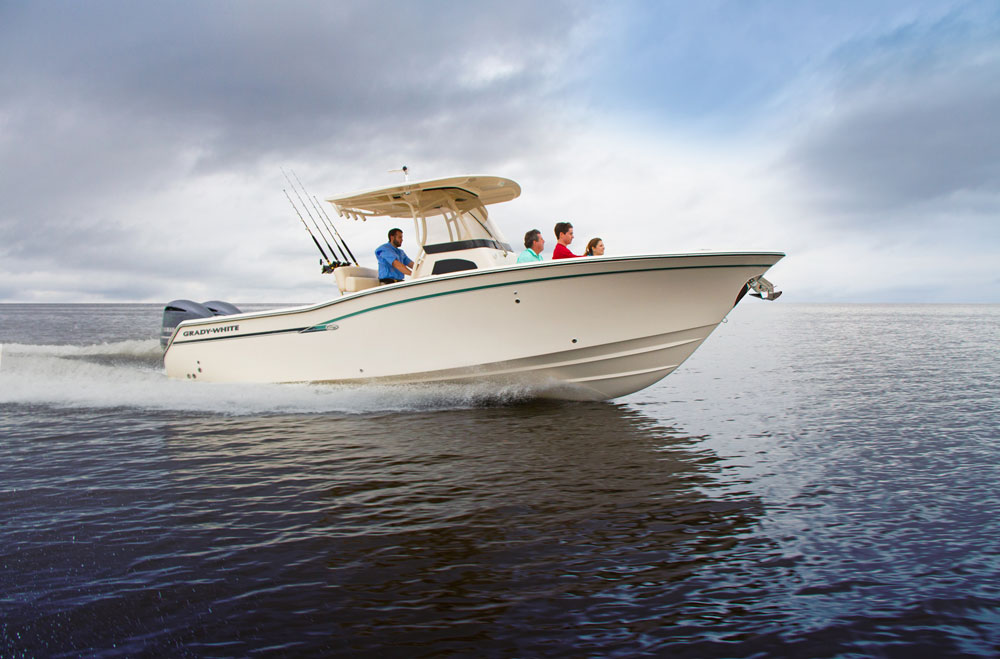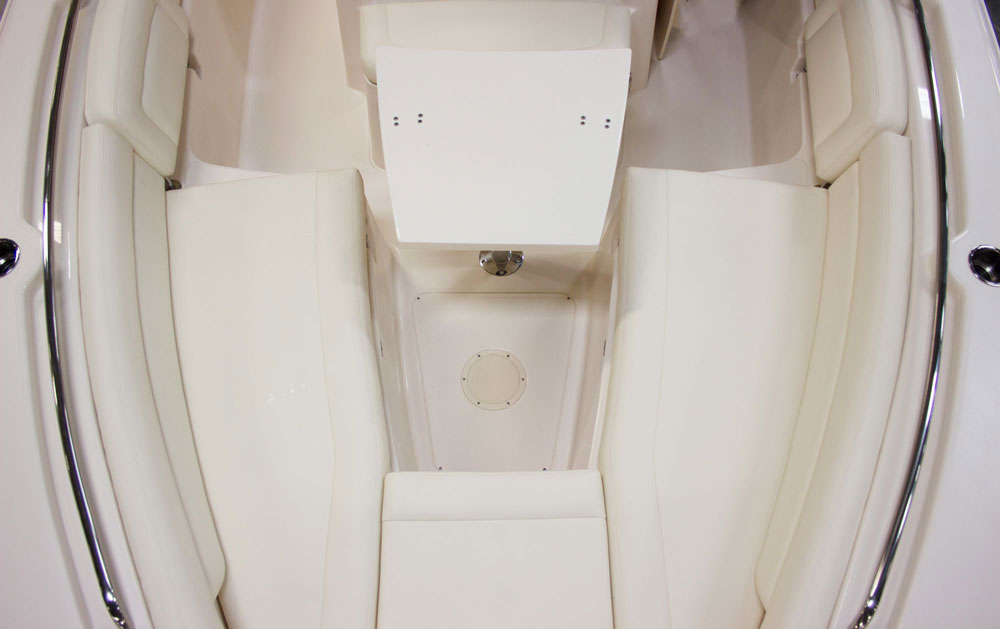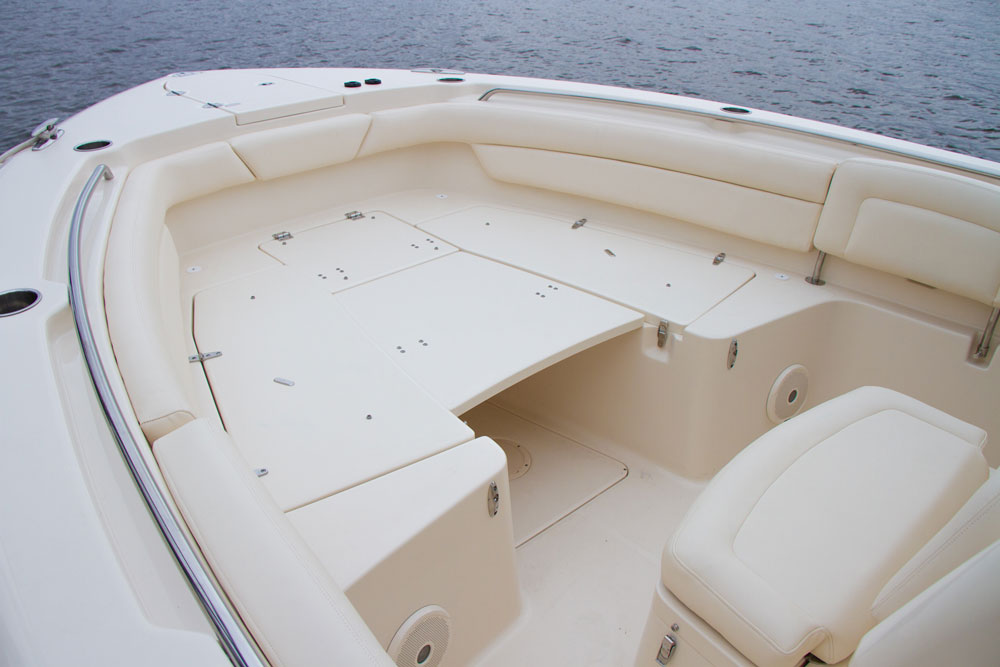Grady White Canyon 271 FS: Bound for Bluewater
This new iteration of the Grady-White Canyon 271 adds family appeal to a blood-and-guts fishing boat.
When Grady-White introduced the original Canyon 271 it was a hard-core fishing boat, through and through. The bow housed a monstrous 400 quart fishbox, which was ringed by coaming bolsters, and was otherwise dedicated to wide-open fishing space. The leaning post had an integrated rigging station, tackle stowage, and a healthy 42 gallon livewell. And a pair of growling Yamaha F300 outboards blasted the boat to offshore fishing grounds at speeds exceeding 55 MPH. The down-side? Due to minimal seating and comfort appointments, if you wanted a boat that did double-duty as a family rig, the 271 wasn’t the best choice. Today you can still get the original 271 Canyon, but as of 2016, Grady-White has provided us with an option that addresses the kinder, gentler side of boating: the Canyon 271 FS.

Adding the Canyon 271 FS to the Grady-White fleet was a smart move, bringing a wider range of anglers into the fold.
As you might guess, the “FS” stands for forward seating. And this is the biggest difference between the old and new models; the 271 has flanking port and starboard seats built into the bow. An insert converts them into a full-sized sunpad, and removable backrests make sitting in a forward-facing position while underway comfortable. The perks: you get seating, a sunpad, and insulated fishboxes or stowage compartments built in under the seats. The drawback: deck space (read: fishing territory) gets eaten up by the seating. The unexpected: Grady-White manages to turn this drawback into another perk.
How can all that stuff in the bow become a good thing from an angling perspective? Insert the center bow sunpad section, remove all the cushions, and you have a bow casting deck. Here’s a view of the bow, set up each way.

With all the cushions in place, the bow becomes a seating area. You can even add a cocktail table. Die-hard anglers don’t really need any of this. But…
True, a bow casting platform isn’t much good to an offshore purist. Who wants to stand and cast from an elevated position when you’re 50 miles offshore, pitching and heaving in oceanic rollers? For those with more diverse tastes, however, it does open up some new angling territory. When casting to tarpon or sight-fishing for cobia, for example, an elevated casting position is quite advantageous.
Grady-White has made some other changes in the 271 FS aside from the bow, too. The console benefits from a redesign, which includes an improved and more protective wrap-around acrylic windshield. The original 271’s extended console forward fishbox is trimmed down, and the standard hard top incorporates built-in lighting. But perhaps the most surprising change is in the latches you’ll find on each and every hatch.
First, a note about Grady-White’s hatches: they are nothing short of magnificent. While that may seem like an absurd claim, a hatch is really a window into any boatbuilder’s sole. Hatches can be built quick and dirty—and they look that way. Or, they can be carefully designed, perfectly fitted, and finished to a tee. Some builders spend as much time on their hatches as other builder spend on an entire boat. In Grady’s case, the hatches are light but strong thanks to RTM molding (which ensures the ideal resin-to-fiberglass ratio); they are fully finished and gel coated both inside and out; the fasteners are flush; the hinges are beefy; they are supported by gas-assist struts; they are gasketed and guttered to prevent water intrusion; and finally, they have sturdy latches. In fact, Grady-White’s hatches are so impressive we used one as our example of the ideal, in this Boating Tips video:
Back to those latches—Grady-White changed them. This is a big move for Grady, which is quite a conservative boatbuilder. They don’t make changes like this quickly, nor often. But the thick rubberized tension latches we’ve seen on their boats for a decade or more are gone, replaced with stainless-steel flip-down latches. Will they prove superior to the rubberized version years from now? Only time will tell. But it’s a safe bet that Grady spent an awful lot of time and effort validating the change. And yes, that shiny stainless-steel does look better than the rubber stuff, too.
Aside from those latches, as far as construction and hull design go the Canyon 271 FS is standard-issue Grady-White. Stem to stern the boat is all composite, and the hull is hand-laid glass rolled out with resin from temperature-controlled tanks. Stringers are encapsulated in resin and glassed to the hull, closed-cell foam is pumped into belowdecks voids, and transoms are reinforced with aluminum angle braces. Grady-White’s reputation for solid construction is well-known so we don’t need to belabor the point, but it’s worth noting that once the boat is complete, they take some extra steps most builders wouldn’t dream of bothering with. Canvass curtains are a great example; they get snapped in place then removed and re-packed for shipping, just to be sure all the straps and fasteners fit properly.
As for the hull-form, the SeaV2 variable-degree deadrise hull (designed by C. Raymond Hunt & Associates) starts with a sharp entry that tapers down to about 30-degrees of deadrise amidships, and 20 degrees at the transom. Wide chines provide a stability boost, and a fair amount of flare in the bow plus multiple strakes help keep spray to a minimum. It’s a proven design, and regardless of Grady’s resistance to change, they’d be nuts to change it.
What about the boat’s performance? Essentially, it’s identical to that of the old Canyon 271. Scroll down the page to see the full performance chart for the 271 (powered by a pair of Yamaha F300 V6 four-stroke outboards). The highlights are a cruise speed of about 43 MPH at 4500 RPM (while burning 29.9 GPH, for 1.5 MPG), and a 56.2 MPH top-end (while burning 51.9 GPH, for 1.1 MPG).
The bottom line? Die-hard fishermen will still gravitate towards the original Canyon 271. But for anglers who have other, more family-oriented needs to fill, the Canyon 271 FS is going to be the stronger contender. Either way, one thing is for sure: if you buy a new Grady-White Canyon, you’ll soon be bound for bluewater.
Other Choices: The Pursuit C 260 is another center console with forward seating, which will appeal to the same crowd. Dittos for the slightly larger Regulator 28 FS. If you want a boat with a stronger tilt towards styling and comfort, also look at the Chris-Craft Catalina 26.
For more information, visit Grady-White.
See Grady-White Canyon 271 and Canyon 271 FS listings.
| Specifications | |
|---|---|
| Length | 26'10" |
| Beam | 9'6" |
| Draft | 1'11" |
| Deadrise | 20 degrees |
| Displacement | 5,790 lbs |
| Fuel capacity | 186 gal. |
| Water capacity | 18 gal. |
| Performance Data | |||
|---|---|---|---|
| Test conditions: calm seas, winds 5 knots, 2 POB. Performance data courtesy of Yamaha. | |||
| RPM | MPH | GPH | MPG |
| 1000 | 6.2 | 2.6 | 2.4 |
| 2000 | 9.6 | 6.9 | 1.4 |
| 3000 | 25.6 | 12.4 | 2.1 |
| 4000 | 37.5 | 22.3 | 1.7 |
| 5000 | 47.2 | 34.9 | 1.4 |
| 6000 | 56.2 | 51.9 | 1.1 |
| Power | Twin Yamaha F300 four-stroke outboards, swinging two 15.25" X 19" three-bladed stainless-steel props. | ||


















